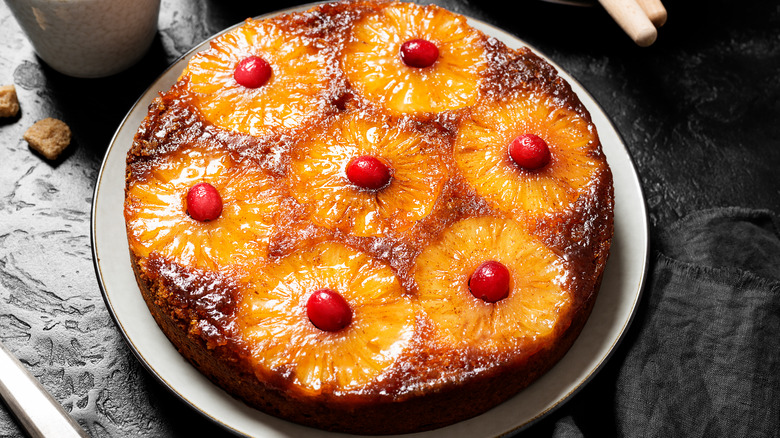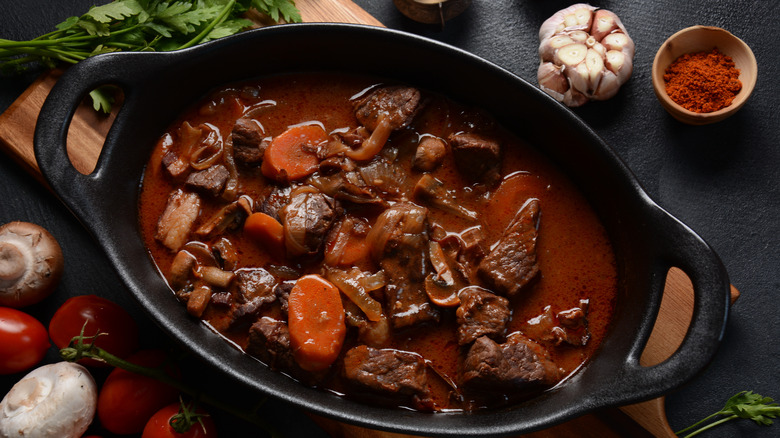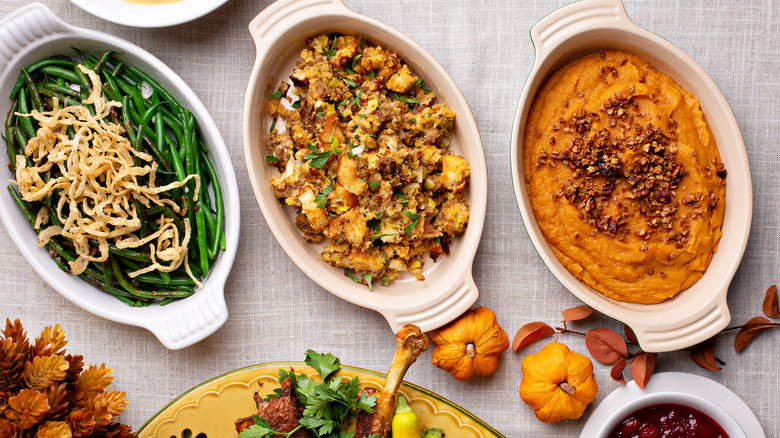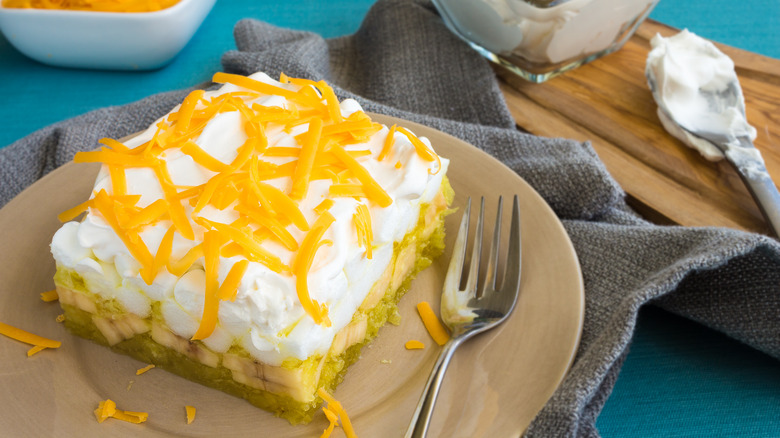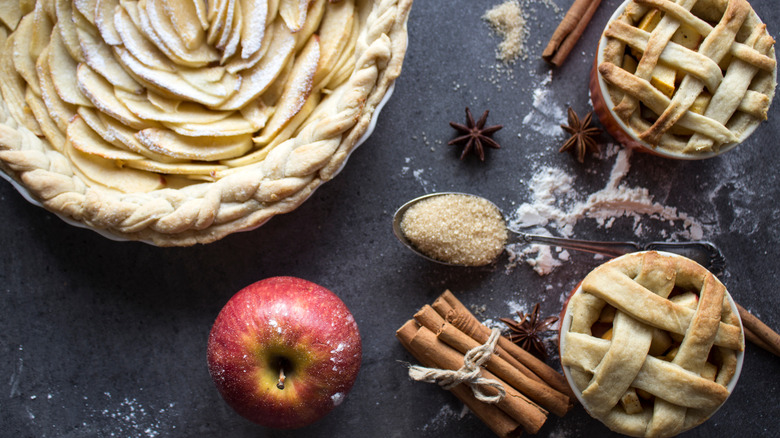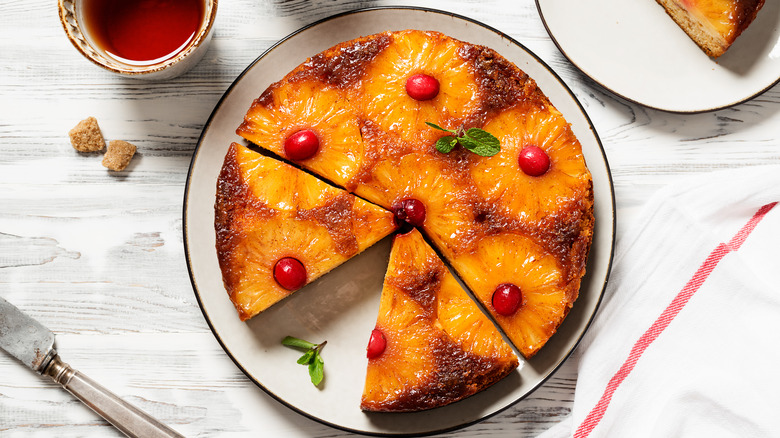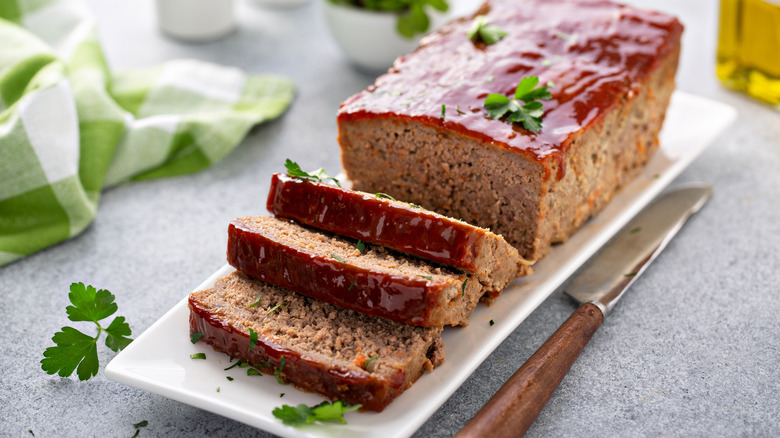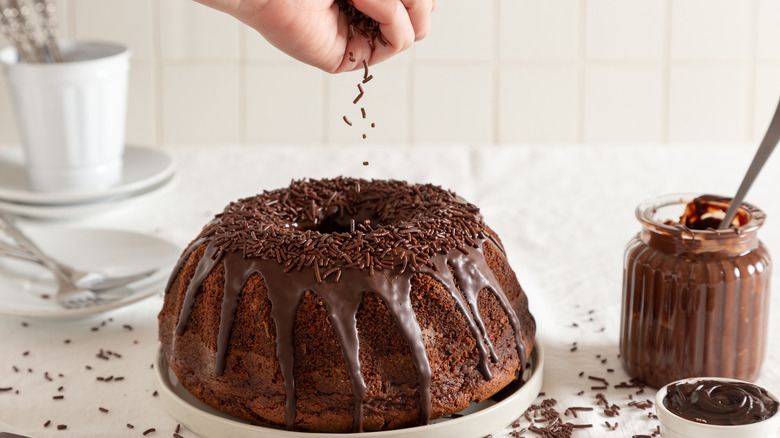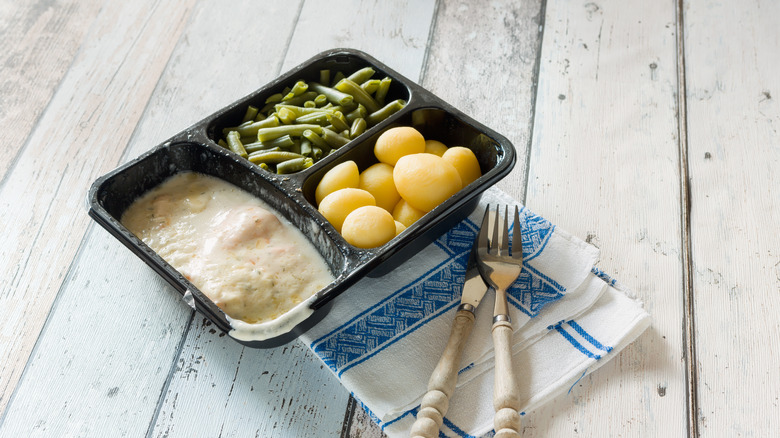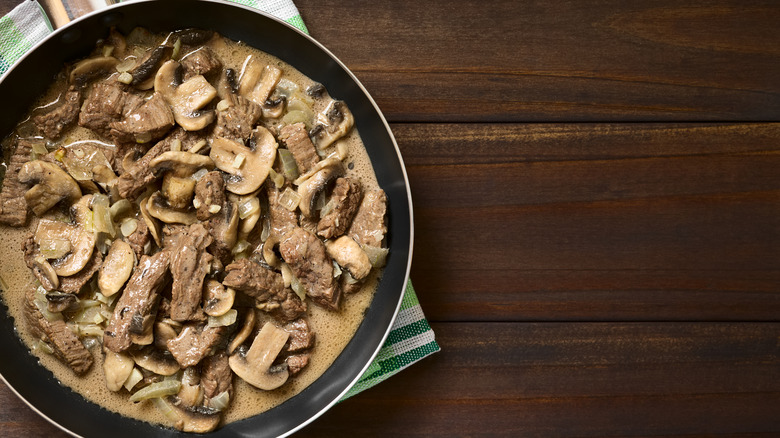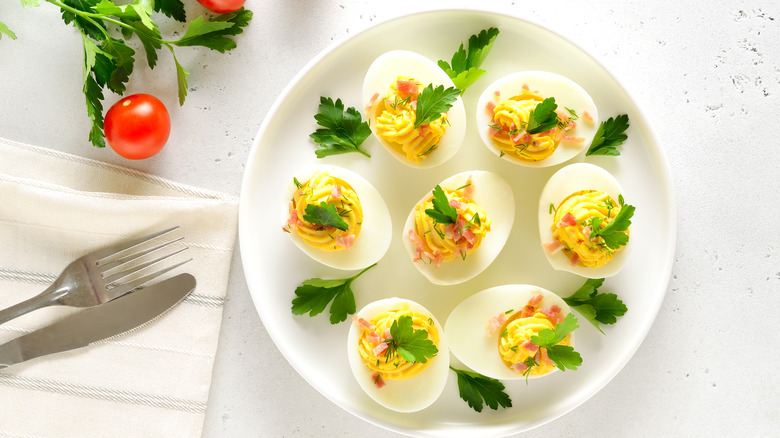Foods From The 1950s That Are Weirdly Making A Comeback
The 1950s were a novel time for American recipes. Fresh out of World War II, American housewives were embracing not only a newfound bounty of once-rationed sugar, butter, and meat, but also a host of convenience foods like powdered gelatin and canned condensed soups. Many of these foods evolved out of wartime need for soldiers, for whom the most important characteristic of any ration was transportability. Now on supermarket shelves, these foods made life easier for housewives, who had been accustomed to spending hours toiling in the kitchen to get meals on the table.
Oddly enough, these convenience ingredients paved the way for many American stalwarts, from casseroles to meatloaf. A combination, then, of hearty, rich comfort foods and quick-and-easy modern marvels were mainstays in the 1950s — and it's no surprise that many such dishes remain nostalgic comfort foods for many to this day. What's more: a good number of these now-retro classics are back in style!
Beef bourguignon
Beef bourguignon certainly wasn't invented in the 1950s. This peasant classic has deep roots in Burgundy, in northeastern France. But the dish became a '50s classic thanks in large part to Julia Child's recipe, which she began sharing to American housewives at her cooking school, which she began operating out of her Parisian kitchen in 1952. While her cookbook didn't make it into the hands of Americans until the '60s, this dish had certainly established itself as a refined contemporary classic on American tables in the decade before Child's media career truly took off.
While comfort food, on the whole, has been enjoying a nostalgic renaissance on the trendiest American tables for over a decade, beef bourguignon has gotten some particular hype of late — and not just because it's being served in space. Recipes for the dish from Anthony Bourdain — about whom the documentary "Roadrunner" was recently released — as well as from Disney have piqued peak interest in this French culinary classic once more.
Casseroles
Casseroles first rose to popularity in the '50s, thanks in large part to recipes printed right on the backs of cans and bags of then-novel convenience foods. Potato chip tuna noodle casserole, for example, first appeared on cans of Jay's potato chips. Green bean casserole, meanwhile, was developed in 1955 for Campbell's Soup.
Over the years, casseroles have ebbed and surged in popularity, but now is resolutely their time to shine. Not only has that old classic green bean casserole returned to American tables during the uncertain times of the pandemic as a bastion of comfort, but French's has opted to create new convenience foods in almost an echo of the ingredients that first paved the way for its original popularity. The company most famous for yellow mustard and freeze-dried fried onions is now also selling green bean casserole snack mix, so you can take the flavors of green bean casserole wherever you go.
Jell-O molds
Jell-O molds in some form have been popular since the Middle Ages, when Europeans served elaborate molded dishes on their fanciest banquet tables. Jell-O salads first found their place on American tables with the advent of instant gelatin back at the beginning of the 20th century, though it wasn't until the post-War rise in popularity of convenience foods that Jell-O molds and Jell-O salads truly got their time to shine.
In the '50s, decorative dishes blending sweet marshmallows and fruit with savory vegetable garnishes, cheese, mayonnaise, and olives were featured on many a dinner table. Today, they are by and large viewed as an odd blip in culinary history.
But Jell-O molds are primed for a comeback. CTV reports that Instagram is abuzz with Jell-o salads in all their picturesque glory, noting that some opt not for gelatin but for agar-agar, a seaweed that makes these 'Grammable dishes plant-based to boot. It's also worth noting that eight years after the end of fan-favorite "The Office's" nine-season run, Jell-O has released a kit allowing fans to recreate the prank where Jim submerged Dwight's stapler in a block of Jell-O.
Homemade pie
The early days of the pandemic saw many home cooks breaking out their flour stores to perfect sourdough loaves and banana bread, but to hear one Washington Post Op-Ed writer tell it, they'd be far better served reviving another nostalgic classic: pie.
In her WaPo piece, Megan McArdle bemoans the loss of the "proper pie" in the American culinary know-how, claiming that this all-American classic may soon fade away for good.
But despite her worries that we have become overly reliant on store-bought crust and shortcuts, homemade pie crust is indeed experiencing a revival. Parade, Macheesmo, and Chowhound all recently explored the benefits of opting for homemade – despite the myriad storebought options out there. All three outlets dubbed homemade the far better option, and if the host of publications offering how-tos for homemade pie crust is any indication, Americans are ready to take this dough back into their own hands.
Pineapple upside-down cake
While according to Sylvia Lovegren's "Fashionable Food: Seven Decades of Food Fads," the first published recipe for pineapple upside-down cake hails from the 1924 Seattle fundraising cookbook, it wasn't until the surge of tiki trends in the '50s that the dessert combining yellow cake, pineapple rings, and maraschino cherries really experienced its heyday. This baked dessert is somewhat similar in design to a French tarte Tatin, with a fruity bottom layer baking under the base — tart dough in the case of the French specialty, or cake batter for the American — before being flipped before serving to unveil the caramelized now-top. And according to The Guardian, thanks to an ever-increasing interest in nostalgic classics, this topsy-turvy classic it's ready for a comeback.
What's more, not only is a classic pineapple upside-down cake returning to American kitchens, but thanks to Disney's Animal Kingdom, the classic cake is now available in shake form, too!
Meatloaf
Depending on who you ask, meatloaf is either a nostalgic fave or a cafeteria nightmare that still haunts you. But regardless of whether you're for or against it, meatloaf was certainly a classic of the '50s dinner table, when ingredients like veggies and breadcrumbs could stretch a mere pound of meat to feed a crowd. According to Bon Appétit, one 1958 book, "365 Ways to Cook Hamburger," included 70 recipes — for meatloaf! (Overkill much?)
Meatloaf is currently experiencing a renaissance, albeit less as the subsistence food of our rationing-minded forebears as a nod to nostalgia. Chef Grayson Schmitz of NYC's Old John's Luncheonette has updated the dish so that it boasts a tender texture and a zesty, mustard-spiked sauce. "It's definitely more of a retro diner item ..." Schmitz admitted, before adding, "We were just trying to go for that homey feel. We're bringing it back," Meanwhile, true to form, Yotam Ottolenghi has created a spiced version made with tuna seasoned with paprika and capers. It's just as delicious hot as cold for a picnic.
Bundt cake
While cakes resembling bundts can be found all over Europe, the pan that gave rise to the popularity of this cake first appeared in the American kitchen in 1950, when, at the behest of local immigrant groups, the Minnesota Nordic Ware company released a metal cake pan similar to kugelhopf pans found in Central Europe. It was the pan that spawned a thousand recipes, and bundt cakes quickly exploded in popularity in the U.S.
While Bundt cakes, writes the Cape Gazette, are all about the pan, it bears mentioning that the recipe that really helped these hollow cakes soar to new heights of popularity was the Tunnel of Fudge cake, invented by Ella Helfrich in 1966. But in the '50s, there were already a wide variety of different flavors, including 7UP bundt cake, with a lemony twist.
But alongside needlepoint and knitting, bundts are hip again. Call it cottagecore or Grandma chic or even, as House Beautiful did, "grandmillennial," but this old-fashioned dessert is more than primed for an encore.
Frozen dinners
Frozen dinners were the convenience food par excellence of the 1950s, and it's not hard to see why. Nothing could be simpler! Simply reheat the tray of pre-portioned food in the newfangled microwave, peel off the plastic, and dig in. But TV dinners of yore were far from a feast for the eyes or the stomach. Indeed, they often featured a ho-hum combo of dry turkey, dry mashed potatoes, and to finish things off, a dry brownie.
But despite these woeful memories, frozen dinners are indeed back — they've just had a makeover for a new generation. Today's frozen dinners are tasty and healthful — we here at Mashed have even profiled 16 of the most popular frozen dinners on the market today. And with delivery options available too, frozen dinners are even easier than they were in the '50s. Mosaic Meals even delivers chef-prepared vegan and vegetarian frozen dinners to reheat and enjoy.
Beef stroganoff
The original recipe for beef stroganoff dates to a late 19th-century contest won by a French chef in Russia, but the dish as we know it today — a combo of beef, mushrooms, and a creamy gravy ladled over boiled dried egg noodles — surged to popularity post-World War II. From a refined dinner party fave belying its European origins, however, stroganoff soon became associated with ho-hum cafeteria food and thus waned in renown.
Today, however, beef stroganoff, along with other nostalgic, comfort food dishes, has seen a dinner table resurgence. Though they pin stroganoff more as a 1970s dish, according to the Daily Mail, searches for nostalgic dishes such as stroganoff have jumped 300%. And just in case all this talk about beef stroganoff has you wanting to revisit the dish — or try it for the first time — we've got you covered with a one-pot recipe for it. Want an even simpler beef stroganoff recipe? This one comes together in under 30 minutes.
Deviled eggs
A cocktail party staple hors d'oeuvre from the 19th century and well into the first half of the 20th century, according to Southern Kitchen, deviled eggs are experiencing a true comeback — with a twist. The relatively simple 1950s finger food that consists of eggs stuffed with a filling made from their own hard-boiled yolks, mayonnaise, and paprika are all dolled up, and once the purview of picnic tables and barbecues, deviled eggs are now appearing on some of America's high dining tables. Chefs behind modern iterations of deviled eggs have spiked this humble bite with everything from squid ink to truffles to caviar and more.
We may have science to thank, at least in part, for deviled eggs' return to the spotlight: after years of being falsely blamed for spiking cholesterol levels, today, most experts agree that eggs are actually heart-healthy and an excellent addition to our diets, rich in protein and minerals. So go on — dance with the devil. There's no harm in it!
